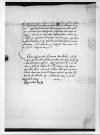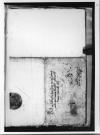Paulo ante, cum hic apud nos oratorio munere fungeretur magnificus ⌊Ieronimus de Lasko⌋, palatinus Siradiensis, inter alia, quae nobiscum nomine serenissimi ⌊Ioannis⌋, regis sui, egit, postulavit a nobis, ut oratoribus, quos ad ⌊caesaream maiestatem⌋ suo nomine mittere vellet, publicae fidei litteras in hanc sententiam procuraremus, ut non solum ire et redire tuto possint, sed ut istic etiam in debito honore et existimatione habeantur. In quo cum negare nobis operam non licuit, mittimus praesentem nuntium nostrum cum litteris ad ⌊caesaream maiestatem⌋, quibus etsi maiestati suae de his ipsis publicae fidei litteris concedendis scribimus, Vestrae tamen Paternitati committimus, ut verbis etiam nomine nostro ab illius maiestate petat operamque suam faciat, ut eaedem litterae in bona forma scriptae per hunc nuntium ad nos mittantur. Credimus enim nulla alia de causa oratores praedictos istuc profecturos, quam ut concordiae rationibus ex consilio et auctoritate ⌊maiestatis caesareae⌋ prospiciant, utque praemoneant illius maiestatem de his, quae vel commodum vel periculum rei publicae Christianae afferre posse videantur.
Ceterum ab aliquot supra mensibus illustris ⌊princeps⌋, in Prussia dux et nepos ex ⌊sorore⌋ noster, per oratorem suum nobis declaravit, quod monitorio poenali ratione terrarum Prussiae et ad instantiam novi magistri seu administratoris designati ⌊ordinis Sanctae Mariae Theutonicorum⌋ peremptoriaque citatione fuerit ad ⌊iudicium camerae imperialis⌋ accersitus, postulavitque a nobis, ut et consilio et auxilio in ea re illi adessemus, suggerens nobis modos, rationes et consilia, quibus et illius institutum et nostrum ius, quod in ⌊terris illis Prussiae⌋ habemus, defendere debeamus: ad cuius rei curam permovet nos quidem et necessitudo, qua nobis est nepos coniunctus, et ius nostrum, quod in Prussiae terras habemus, sed in ista tamen illius a religione discessione veremur, ne nostram causam simul cum illius negotio defendentes in invidiam aliquam vel sinistram opinionem apud innocentissimum et castissimae religionis ⌊caesarem⌋ incurramus. Quare mittimus ad Vestram Paternitatem omnia ipsius illustris domini ⌊ducis Prussiae⌋ consilia in scriptis redacta et committimus ei, ut illis perlectis ea in defensionem iuris nostri et causae nepotis apud ⌊caesaream maiestatem⌋ agat, quae Vestrae Paternitati pro captu ingenii et prudentia sua tum ad rem pertinere, tum ex dignitate nostra esse magis videbuntur.
Faceremus non inviti, quod Vestra Paternitas crebris suis litteris rogat, ut illam tandem ad nos revocemus, verum quia iste indutiarum in ⌊regno Hungariae⌋ receptus animus(?) et item  BJ, 91, f. 7v alia magni momenti negotia multiplicarunt nobis occasionem saepius agendi cum ⌊caesarea maiestate⌋, quod ubi istinc Vestra Paternitas abesset, ita commode et utiliter per alium praestare non possemus, quare illam hortamur, ferat adhuc moram istam suam patienter, quamdiu istic in ⌊Germania⌋ caesarea maiestas perseverabit, vel quamdiu publica maiora negotia non transigentur. Cum enim aut ⌊caesaream maiestatem⌋ in ⌊Hispaniam⌋ abscedere aut maiora negotia absoluta esse cognoverimus, nihil morabimur, Vestram Paternitatem revocare.
BJ, 91, f. 7v alia magni momenti negotia multiplicarunt nobis occasionem saepius agendi cum ⌊caesarea maiestate⌋, quod ubi istinc Vestra Paternitas abesset, ita commode et utiliter per alium praestare non possemus, quare illam hortamur, ferat adhuc moram istam suam patienter, quamdiu istic in ⌊Germania⌋ caesarea maiestas perseverabit, vel quamdiu publica maiora negotia non transigentur. Cum enim aut ⌊caesaream maiestatem⌋ in ⌊Hispaniam⌋ abscedere aut maiora negotia absoluta esse cognoverimus, nihil morabimur, Vestram Paternitatem revocare.
Quam interim in gratia et benevolentia nostra regia conservabimus, prout hactenus fecimus. Et eam bene valere optamus.
 BJ, 91, f. 7v alia magni momenti negotia multiplicarunt nobis occasionem saepius agendi cum
BJ, 91, f. 7v alia magni momenti negotia multiplicarunt nobis occasionem saepius agendi cum 

